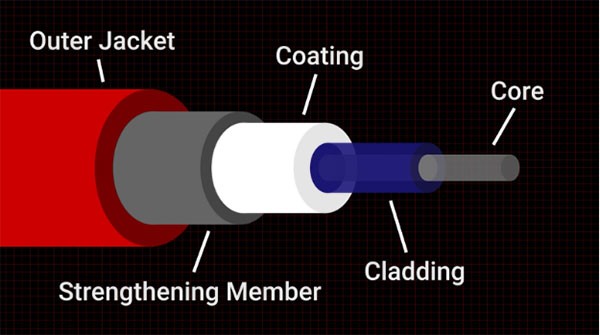
What is the difference between single-mode and multi-mode fiber optic cables?
Fiber Optic ADSS Cables
1. Core Diameter:
- Single-Mode Fiber:
Single-mode fibers have a smaller core diameter, typically around 9 microns (µm). This narrow core allows the light to travel directly down the fiber, minimizing light reflections within the core. - Multi-Mode Fiber:
Multi-mode fibers have a larger core diameter, generally between 50 and 62.5 microns. This wider core permits multiple modes (paths) of light to be transmitted simultaneously, which can lead to modal dispersion.
2. Transmission Distance:
- Single-Mode Fiber:
Single-mode fibers are designed for long-distance communication. They can transmit data over distances of up to 80-100 kilometers (50-62 miles) without significant signal loss, making them ideal for long-haul telecommunications and intercontinental links. - Multi-Mode Fiber:
Multi-mode fibers are more suited for shorter distances, typically up to 2 kilometers (1.24 miles) depending on the fiber grade and data rate. They are commonly used in local area networks (LANs), data centers, and within buildings.
3. Light Source and Wavelength:
- Single-Mode Fiber:
Single-mode fibers typically use a laser as the light source, operating at wavelengths of 1310 nm or 1550 nm. The laser provides a focused beam that travels straight down the core, enabling high-speed data transmission over long distances. - Multi-Mode Fiber:
Multi-mode fibers generally use LED light sources, which produce multiple light paths. They operate at wavelengths of 850 nm or 1300 nm. The multiple light paths can cause dispersion, which limits the effective distance for data transmission.
4. Bandwidth and Data Capacity:
- Single-Mode Fiber:
Due to the single light path and minimal modal dispersion, single-mode fibers offer higher bandwidth and data capacity. They are capable of supporting high-speed networks like 100 Gbps and beyond, which is crucial for long-distance communication and high-demand applications. - Multi-Mode Fiber:
Multi-mode fibers, while offering sufficient bandwidth for most local applications, have lower data capacity compared to single-mode fibers. They are typically used for data rates up to 10 Gbps, although newer grades (OM4 and OM5) can support higher speeds over shorter distances.
5. Cost:
- Single-Mode Fiber:
Single-mode fiber cables and the associated equipment (like lasers) tend to be more expensive due to the complexity and precision required for long-distance, high-speed data transmission. - Multi-Mode Fiber:
Multi-mode fibers are generally less expensive than single-mode fibers. The LEDs used as light sources are cheaper, and the installation process is often simpler, making it more cost-effective for short-range applications.
6. Applications:
- Single-Mode Fiber:
Single-mode fibers are predominantly used in long-distance communication systems, such as intercity and international telecommunications, large-scale enterprise networks, and cable TV networks. - Multi-Mode Fiber:
Multi-mode fibers are commonly used in environments where transmission distances are shorter, such as within data centers, in-campus networks, and small to medium-sized enterprise networks.
Total Visitors
1835
1835
Countries
0
0
Users
732
732
Products
172
172
